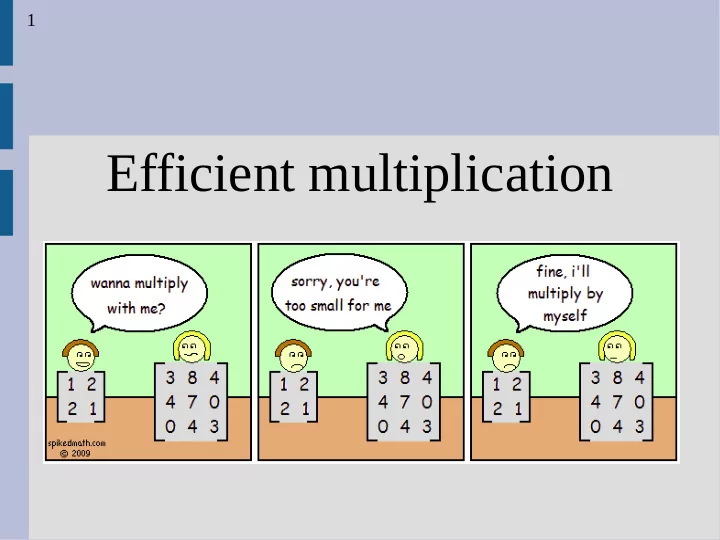

1 Efficient multiplication
2 Matrix multiplication If you have square matrices A and B, then C = A*B is defined as: Takes O(n 3 ) time
3 Matrix multiplication Can we do better? What is the theoretical lowest running time possible?
4 Matrix multiplication Can we do better? Yes! What is the theoretical lowest running time possible? O(n 2 ), must read every value at least once
5 Matrix multiplication Block matrix multiplication says: Thus C 1 = A 1 *B 1 + A 2 *B 3 , We can use this fact to make a recursive definition
6 Matrix multiplication Divide&conquer algorithm: Mult(A,B) If |A| == 1, return A*B (scalar) else... divide A&B into 4 equal parts C1 = Mult(A1,B1) + Mult(A2,B3) C2 = Mult(A1,B2) + Mult(A2,B4) C3 = Mult(A3,B1) + Mult(A4,B3) C4 = Mult(A3,B2) + Mult(A4,B4)
7 Matrix multiplication Running time: Base case is O(1) Recursive part needs to add two n/4 x n/4 matrices, so O(n 2 ) 8 recursive calls, each size n/2 T(n) = 8 T(n/2) + O(n 2 ) T(n) = O(n log2 8 ) = O(n 3 )
8 Strassen's method Although the simple divide&conquer did not improve running time... Can eliminate one recursive call to get O(n log2 7 ) with fancy math Has a much larger constant factor, so not useful unless matrix big
9 Strassen's method Step 1: compute some S's (just 'cause!) S1=B2-B4 S6=B1+B4 S2=A1+A2 S7=A2-A4 S3=A3+A4 S8=B3+B4 S4=B3-B1 S9=A1-A3 S5=A1+A4 S10=B1+B2
10 Strassen's method Step 2: compute some P's (7 < 8) P1=A1*S1 P2=S2*B4 P3=S3*B1 P4=A4*S4 P5=S5*S6 P6=S7*S8 P7=S9*S10
11 Strassen's method Step 3: C1 = P5 + P4 - P2 + P6 C2 = P1 + P2 C3 = P3 + P4 C4 = P5 + P1 - P3 - P7 (Book works out algebra for you)
12 Strassen's method In practice, you should never use this on a matrix smaller than 16x16 The break-point is debatable, but Strassen's is better if over 100x100 Theoretical methods exist to reduce to O(n 2.3728639 ), but not practical at all
13 Fast Fourier Transform The FFT is a very nice algorithm (ranks up there with bucket sort) It has many uses, but we will use it to solve polynomial multiplication Naive approach takes O(n 2 ) time (i.e. FOIL)
14 Fast Fourier Transform Assume we have polynomials: C(x) = A(x) * B(x) O(n) per c j , up to 2n c j 's = O(n 2 )
15 Fast Fourier Transform Rather than directly computing C(x), map to a different representation A(x) = (x 0 , y 0 ), (x 1 , y 1 ), ... (x n , y n ) Theorem 30.1: If x i ≠ x j for all i ≠ j, then above gives a unique polynomial
16 Fast Fourier Transform Proof: (direct) Represent in matrix form: [1 x 0 x 0 2 ... x 0 n ] [a 0 ] [y 0 ] [1 x 1 x 1 2 ... x 1 n ] [a 1 ] = [y 1 ] ... ... ... [1 x n x n 2 ... x n n ] [a n ] [y n ] The left matrix is invertible, done
17 Fast Fourier Transform Q: Why bother with point-values? A: We can do A(x) * B(x) in O(n) in this space Namely, (x i , cy i ) = (x i , ay i *by i ) Need to get to point-value and back to coefficients in less than O(n 2 )
18 Fast Fourier Transform done Coming soon! (next time)
Recommend
More recommend